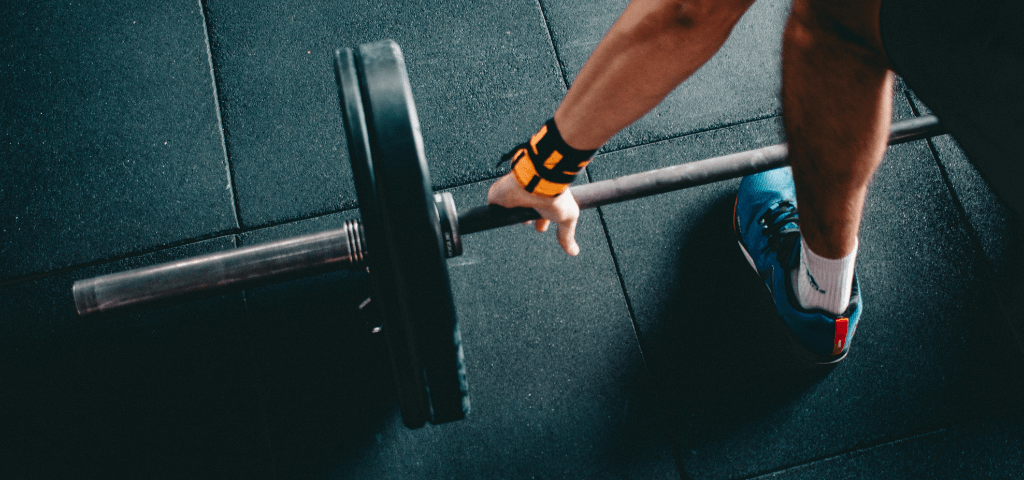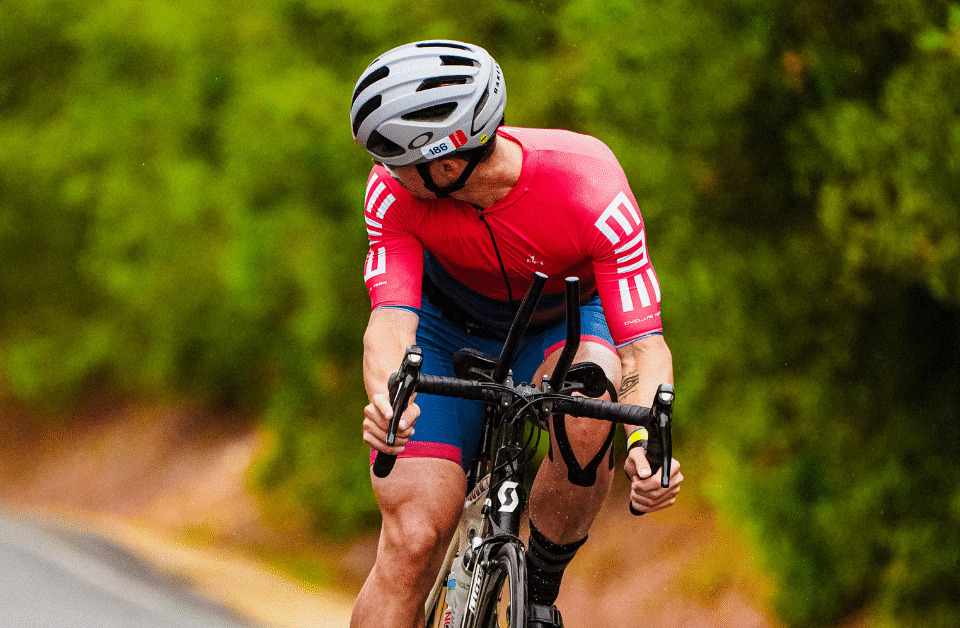
How to lose weight on a bike without going hungry: mistakes, tips, and action plan
19 December 2024
Training zones in cycling – a comprehensive guide from the world tour
16 January 2025
For decades, strength training in cycling has been a topic of much debate. Many believed that “more muscles” meant “more weight to carry,” which for cyclists seemed more like a problem than an advantage.
Today, however, we know that well-planned strength training can bring incredible benefits in terms of both power and endurance. In this article, you’ll learn why this is the case and how to effectively incorporate strength training for cyclists into your routine!
What will you find in this article?
- How to effectively combine strength training with cycling?
- Eccentric strength training for cyclists
- Plyometrics – a practical way to build cyclist power
- Block periodization in strength training for cyclists
- Strength training for cyclists: a sample workout plan
- Training recommendations for different skill levels
- Summary – strength training for cyclists
How to effectively combine strength training with cycling?
Integrating strength training with cycling is key to balancing the development of strength with endurance. One of the main challenges is avoiding the interference effect—a phenomenon where adaptations from one type of training can inhibit progress from the other. Research from the Australian Institute of Sport (2024) indicates that proper scheduling of these training types can minimize this effect.
On a molecular level, the interference effect stems from the activation of opposing signaling pathways:
- Endurance training activates the AMPK pathway, which supports energy metabolism but inhibits muscle protein synthesis.
- Strength training activates the mTOR pathway, responsible for protein synthesis and muscle growth.
Because activating one pathway can suppress the other, it’s crucial to plan your training to minimize this conflict.
Key principles of training integration
- Order of training sessions:
If strength and endurance training are on the same day, start with endurance training, leaving at least six hours before strength training. This allows muscles to recover and prevents the AMPK pathway from dominating recovery processes. - Spacing intense sessions:
Separate intense strength training from your hardest cycling sessions by at least a day to allow for recovery and adaptation. - Intensity and volume of strength training:
Cyclists should avoid focusing too much on hypertrophy (muscle growth) to prevent weight gain. Instead, aim to improve relative strength and muscular endurance.
Eccentric strength training for cyclists
Traditional strength training emphasizes the concentric phase of movement—muscle shortening while generating force. However, research from the University of Queensland (2023) shifts the focus to the eccentric phase—muscle lengthening while under tension—which plays a critical role in cycling efficiency, especially on steep climbs. During these moments, muscles control the pedal return and counteract gravitational forces.
Studies show that eccentric training leads to unique muscle adaptations. At the microscopic level, it increases structural proteins in sarcomeres—the smallest contractile units of muscles. After eight weeks of regular eccentric training, muscles become more resistant to microtears, and their energy efficiency significantly improves.
What makes the eccentric phase special?
Muscles consume less energy during the eccentric phase but can generate more force compared to the concentric phase. This explains why you can lower a 120 kg weight but struggle to lift 80 kg from the ground.
In cycling, this knowledge allows for better workout planning: focusing on the eccentric phase enhances strength while minimizing metabolic fatigue and injury risk.
Plyometrics – a practical way to build cyclist power
Plyometric training leverages the stretch-shortening cycle (SSC)—the natural ability of muscles and tendons to store energy during stretching and release it during contraction. This mechanism is crucial for efficient pedaling. Research from the University of Jyväskylä (2024) shows that regular plyometric training can increase maximum power output by up to 15% in 12 weeks. For instance, a rider generating 1000 watts in a sprint could boost this to 1150 watts—a difference that often determines the winner.
Key benefits of plyometrics
Plyometric adaptations enhance both muscles and the nervous system. Faster motor unit recruitment and improved intermuscular coordination result in more efficient and fluid pedaling. Cyclists not only generate more power but also do so in a more optimized way.
The central mechanism in plyometric training is the stretch reflex. When a muscle is rapidly stretched, muscle spindles—receptors that detect stretch—trigger a response that increases the force of the subsequent contraction. This is particularly important in cycling sprints and dynamic accelerations, where both power and speed are essential.
Block periodization in strength training for cyclists
Modern strength training for cyclists often relies on block periodization, a strategy that divides the training cycle into blocks, each lasting 4–6 weeks, focusing on specific physical attributes. This approach enables cyclists to effectively combine strength and endurance training, maximizing adaptations in both areas.
| Block | Anatomical adaptation | Functional hypertrophy | Maximum power | Conversion phase |
|---|---|---|---|---|
| Goal | Prepare tissues for higher loads in subsequent training phases. | Develop strength and muscle mass without significantly increasing total body weight—key for cyclists focusing on relative strength. | Maximal motor unit activation and the ability to generate force quickly. | Transfer the developed strength and power from training to cycling—improve pedaling efficiency and specificity. |
| Characteristics | 12–15 repetitions with moderate weights to improve technique and control. | Average 6–8 repetitions with moderate to heavy weights to stimulate muscle adaptations. | Very low repetition range (2–3) with maximum quality movement and long rest intervals between sets. | Combination of strength exercises and cycling-specific training. Exercises performed dynamically with lower weights. |
| Mechanism | Strengthens tendons, ligaments, and connective tissues, reducing injury risk and improving muscle vascularization. | Selective hypertrophy of type IIa muscle fibers (fast-twitch and fatigue-resistant). | Neural adaptations: improved recruitment and synchronization of motor units. | Integration of new motor patterns in the context of cycling tasks. Improves pedaling efficiency and economy. |
| Intensity | Load at 50–60% of maximum weight. | Load at 75–85% of maximum weight. | Load at 95–100% of maximum weight. | Load at 55–70% of maximum weight, performed with greater speed and control. |
Strength training for cyclists: sample exercises for each block
| Block | Anatomical adaptation | Functional hypertrophy | Maximum power | Conversion phase |
|---|---|---|---|---|
| Example exercises: Beginners | – Bodyweight squats – Static lunges – Push-ups – Plank – Glute bridge – Deadlifts with kettlebell – Band pull-aparts – Bird dog | – Goblet squats with kettlebell – Bulgarian split squats – Dumbbell rows – Weighted glute bridges – Step-ups – Push-ups plus – Deadbugs – Cable woodchops | – Jump squats – Jump lunges – Low box jumps – Medicine ball throws – Lateral hops – On-the-spot sprints – Skipping A – Explosive jump squats | – Single-leg press – Wall slides – Band-resisted sprints – Monster walks – Isometric squats – Good morning with bands – Kneeling planks – Stability ball jackknifes |
| Example exercises: Intermediate | – Front squats with barbell – Reverse lunges with dumbbells – Dips – Barbell rows – Romanian deadlifts (RDL) – Pallof press – Face pulls – Side plank with rotation | – Back squats with barbell – Single-leg Romanian deadlifts – Barbell bent-over rows – Barbell hip thrusts – Split squats – Pull-ups – Overhead barbell press – Plank with reach | – Drop jumps – Depth jumps – High box jumps – Power cleans with kettlebell – Barbell jump squats – Rotational medicine ball throws – Bound skips – Reactive lunges | – Force plate jumps – Eccentric squats – Nordic hamstring curls – Reverse Nordic curls – Plyometric lunges – Depth drops – Assisted jumps – Resistance band sprints |
How to structure it in practice?
One of the key aspects of effectively applying block periodization is dedicating the right amount of time to each stage of training. Progression should not be rushed—each phase requires an adequate amount of time for the body to adapt to new loads and master the technique.
Each of these blocks should last between 4 and 6 weeks, depending on the goal and the athlete’s level of advancement. Training should be synchronized with the competition period to achieve peak cycling performance at key moments.
Strength training for cyclists: a sample workout plan
This plan balances strength and cycling training for an advanced amateur cyclist aiming to improve group riding skills or performance in cycling races.
Period: Preparatory
Duration: November – February
| Monday | Tuesday | Wednesday | Thursday | Friday | Weekend |
| Morning Strength training (60–75 min) * Focus on eccentric exercises * 4–5 compound exercises * 3–4 sets, 6–8 reps Afternoon Recovery ride (60 min, Z2) | Interval training on the trainer (90 min) * Sweet spot or threshold work * Can be combined with short sprints | Day off | Morning Strength training (60 min) * Focus on power * Compound + isolated exercises Afternoon Light ride Z1/Z2 (45 min) | Interval training on the trainer (90–120 min) * Higher intensity * Focus on addressing weaknesses | – Long endurance rides – Optional strength session Sunday evening |
Period: Summer
Duration: March – September
| Monday | Tuesday | Wednesday | Thursday | Friday | Weekend |
| Morning Short strength session (40 min) * Maintenance * 6–7 exercises in 2 sets, 50–60% of max weight Afternoon Recovery ride (60 min) | Quality cycling training (2–3h) * Intervals/threshold work * Can be combined with sprints | Morning Quick gym session (30 min) * Plyometrics + core Afternoon Technical training (90 min) | Main training session (2–3h) * Power-focused work * Race simulations | Short activation training (60–90 min) * Preparation for the weekend * Possible short accelerations | – Races or long training sessions – No strength training |
Key principles for all levels
- Consistency: Regular training is more important than volume. It’s better to train less but consistently.
- Quality over quantity: Proper technique is critical—using lighter weights with correct movement patterns is safer and more effective than risking injury.
- Recovery: Adequate sleep, a balanced diet, and managing fatigue are fundamental to effective training.
Training recommendations for different skill levels
Beginner cyclists:
- Focus on learning proper technique and adapting your body to new stimuli.
- Start with 2 training sessions per week, performing compound exercises that engage the whole body.
- Seek advice from a personal trainer if you are unsure about your technique.
Intermediate cyclists:
- Once you’ve built a solid foundation, introduce block periodization.
- Focus on more targeted aspects of strength, such as functional hypertrophy or maximum power.
- Integrate strength training with cycling, ensuring proper intensity distribution.
Advanced cyclists:
- Limit strength training to 1–2 sessions per week, but increase their intensity and quality.
- Use an individualized approach and precise periodization to optimize results.
- Regularly monitor fatigue levels and manage recovery to avoid overtraining.
Summary – strength training for cyclists
Modern strength training in cycling is much more than just “going to the gym.” Contemporary research clearly shows that consistent strength work is key not only to improving power but also to enhancing health and longevity in the sport.
This is particularly important for amateur cyclists, who often need to balance training with a professional, sedentary lifestyle.
Amateur cyclists face unique challenges:
- Sedentary lifestyle: Long hours sitting at a desk, limited daily activity, and later intense effort on the bike can lead to muscle imbalances.
- Sarcopenia: The natural loss of muscle mass begins as early as age 35, highlighting the need for strength training as a preventive measure.
Strength training in cycling not only improves performance but also supports health and prevents injuries. Regardless of your skill level, it’s worth approaching it thoughtfully and treating it as an integral part of your athletic development.
Thinking about cycling training? If you want to take your riding to the next level, we have a great option for you:
- Individual coaching – work one-on-one with an experienced coach who will continuously adjust your training load to your needs and support your development as a cyclist.

